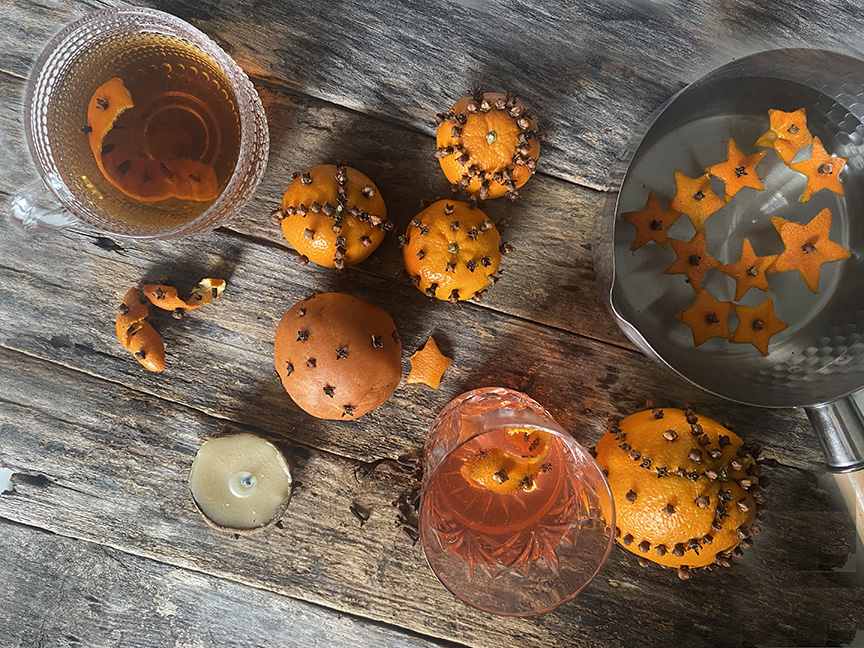
Sorry! Sometimes I have to give in to my terrible alliteration tendencies. This post is all about pomanders in every form. I love the smell of oranges and cloves together more than most things– it’s one of those things I never get tired of. So I decided to go nuts and collect a whole bunch of the various pomander projects I’ve done over the years in one convenient place!
Pomander balls have been associated with Christmas and/or Winter Solstice for some time, but that isn’t how they originated. We think of them as oranges studded with cloves, but in medieval Europe, people would keep little satchels of herbs on them because most everyone and everything smelled bad. They became a status symbol and the wealthier you were the fancier your herbs were. Cloves and orange rind, while common enough today were expensive and exotic spices. The gold standard of showy scents however was ambergris, which led to the french term pomme d’ambre. (Apple of amber- they were often carved into circles) Pomme d’ambre became pomander. At some point this habit of sweet smelling herbs naturally expanded to leaving spices and citrus around the house, particularly when people would be visiting for the holidays. The clove studded oranges that we know and love really came into their own during the Victorian period, although in America at least, they are often erroneously associated with early American colonists because colonial Williamsburg uses them to decorate. In reality, the american colonists did not decorate for the holidays at all. Regardless, the smell of clove and orange instantly transport me to a holiday state of mind and I like them in just about any form!
Oranges in Western symbolism always seem to echo the sun. They are bright and sun colored making them especially appropriate for the Winter Solstice. They also are tied to wealth. While it can be hard to imagine now, you really can’t grow them outside of their range without an expensive greenhouse, so for a long time they were a status symbol. In Eastern symbolism oranges bring luck and prosperity. Cloves are the dried flower buds of syzygium aromaticum, a tropical tree in the myrtle family once found only in Indonesia and closely guarded. It’s generally is associated with keeping away negativity.
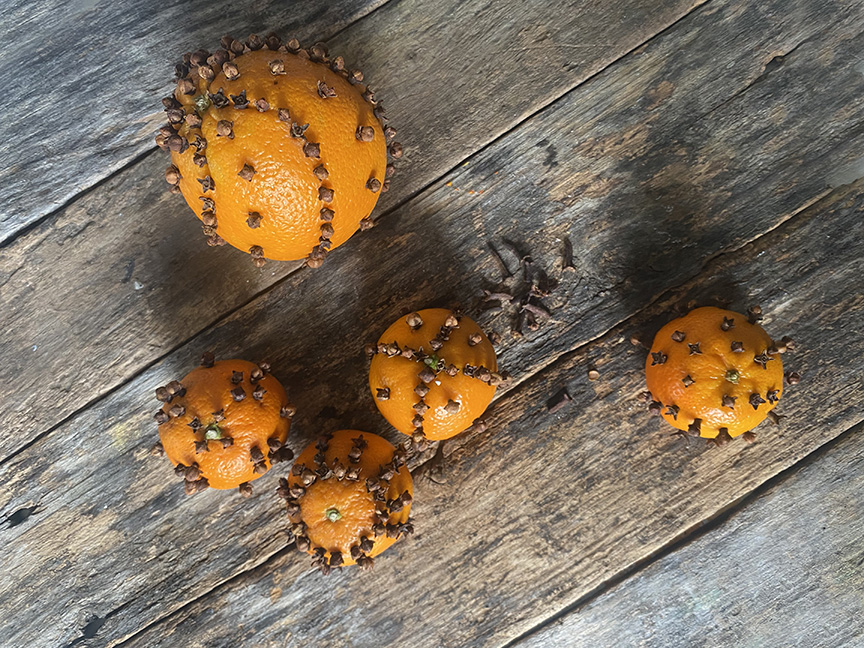
Making Pomanders
Making a classic pomander is a simple craft perfect for a variety of ages. The materials lits is light, you can work in or outside and if little decide to take a taste its ok! They are a classic for a reason- they smell amazing!! You can often get them to dry out whole in a warm dry house, some people douse them in dried cinnamon to reduce the chance of mold, but I prefer the natural color so I gamble, knowing that I’ll loose a few.
Materials:
- whole unpeeled oranges and/or clementines
- whole cloves
- toothpick
Method:
Use the toothpick to make holes and then poke the cloves into the oranges. You can make geometric lines, patterns, suns or go completely random. (Always my kids’ favorite…)
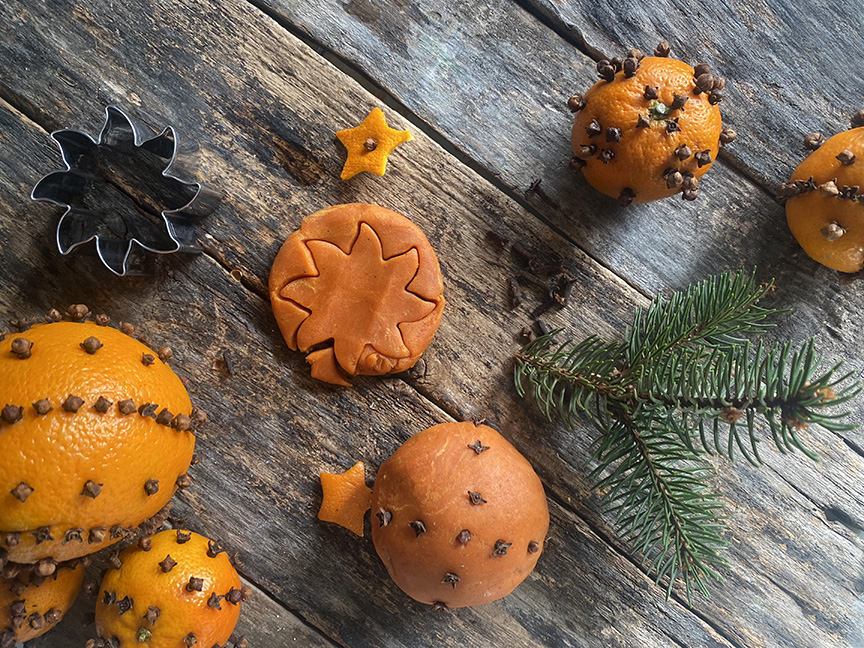
Pomander Playdough
This is one of the standard holiday scented playdoughs I make most years. Unlike the other three scents though, I always save a little bit of this for myself to absently squish and smell. This uses orange extract which you can get in the baking aisle of most supermarkets. You can also use orange oil or orange essential oil, but reduce the quantity somewhat because they are stronger. You can adjust the orange and the clove to get the scent level you like, they won’t affect the dough. I rarey measure and just dump things in.
Materials:
- 1 1/4 cups water
- 1/2 cup + 2 TBS salt
- 3/4 tablespoon cream of tartar
- 2 1/2 tablespoons of vegetable oil
- 1 1/4 cups flour
- 1/2 TBS ground cloves
- 1 tsp orange extract (or orange oil)
- orange food coloring
Method:
Place the water, salt, cream of tartar, oil, and flour into a saucepan whisk until smooth-ish.
Cook, stirring frequently, over low heat until most of the water has evaporated and a stiff dough has formed. You will have to switch to a spoon or scraper towards the end.
Tip the playdough onto the counter and allow to cool a bit. Once it’s cool enough to touch, flatten out the dough and sprinkle the cloves, orange extract and a few drops of food coloring. Knead them into the dough evenly adding more as desired.
Store in an airtight container in the fridge.
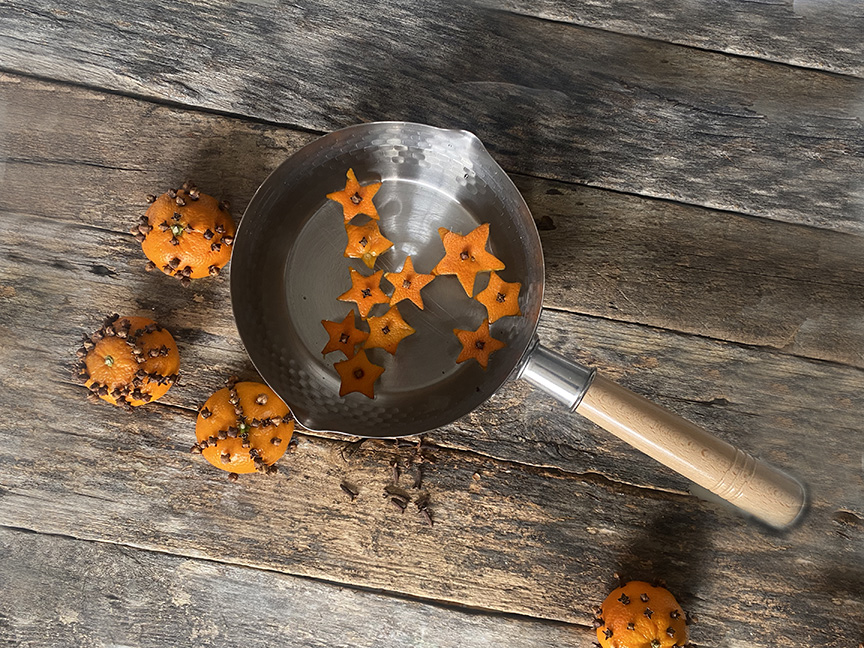
Pomander Simmer Pot
I think by now that it is crystal clear that I LOVE the smell of oranges and cloves together. This simmer pot celebrates them in all their glory. I got fancy for the picture and cut out little star shapes from my orange rinds with a cookie cutter, but it will smell just as good with a jagged peel and a handful of cloves. Eat the fruit and just use the peel- waste not want not! If you are’t familiar with simmer pots learn more here!
Materials:
- orange peels (or clementine peels)
- whole cloves
- water
- pot
Method:
Bring the water, peels and cloves to a boil. Reduce to a simmer and let that pomander scent fill teh air. Top up with more water as it starts to look low and of course never leave unattended.
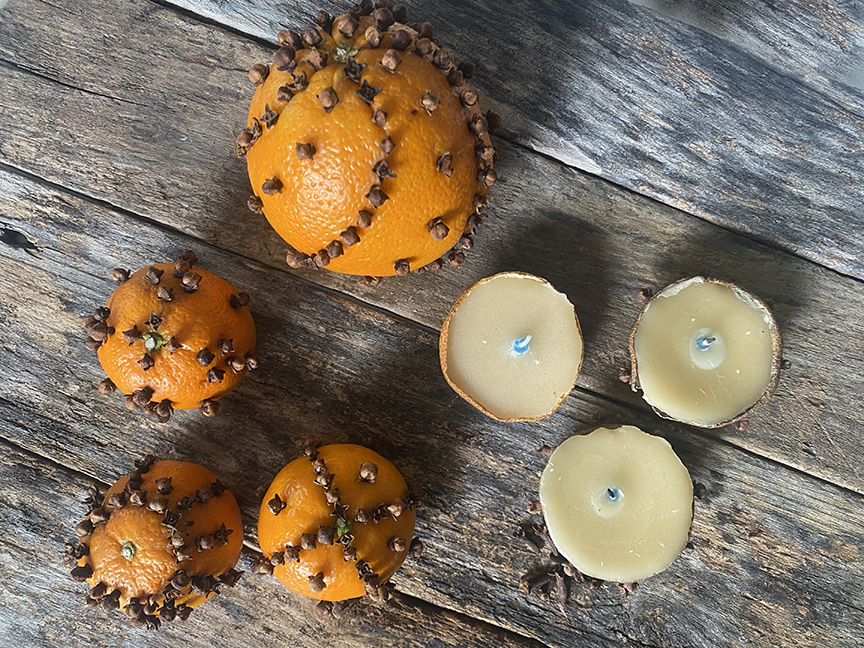
Pomander Candles
Click here for the full tutorial!
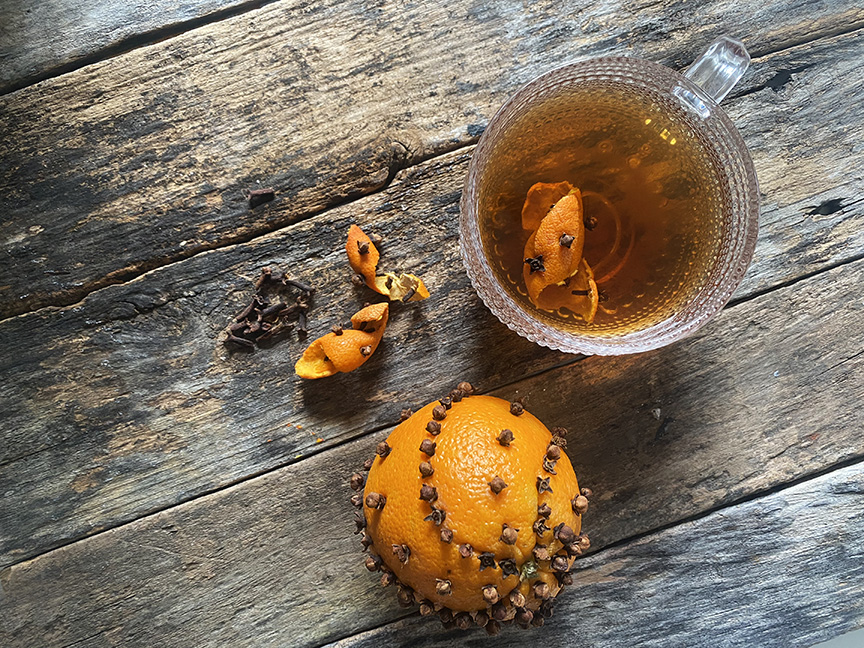
Pomander Tea/ Hot Toddy
This is such an easy and festive way to dress up tea. You can make the zests a few hours ahead of time and use them as needed. The heat of the tea makes the scent come alive. This is great in plain tea and lovely in a hot toddy. (the latter is obviously not for kiddos) It’s also great with my rock and rye hot toddy if you want to take things up a level.
Ingredients:
- strips of orange zest
- whole cloves
- a favorite tea, one with orange or spice is especially good
- honey (optional)
- a nip of your favorite spirit (optional: bourbon or cointreau would both be delish)
Method:
Poke cloves into your strip of orange zest and then twist it so it looks pretty.
Steep your tea of choice with the hot water in a cup for a few minutes.
Remove the tea bag and stir in honey and/or spirits.
Garnish with the pomander zest and enjoy!

Pomander Mushroom Ornaments
Click here for the full tutorial!
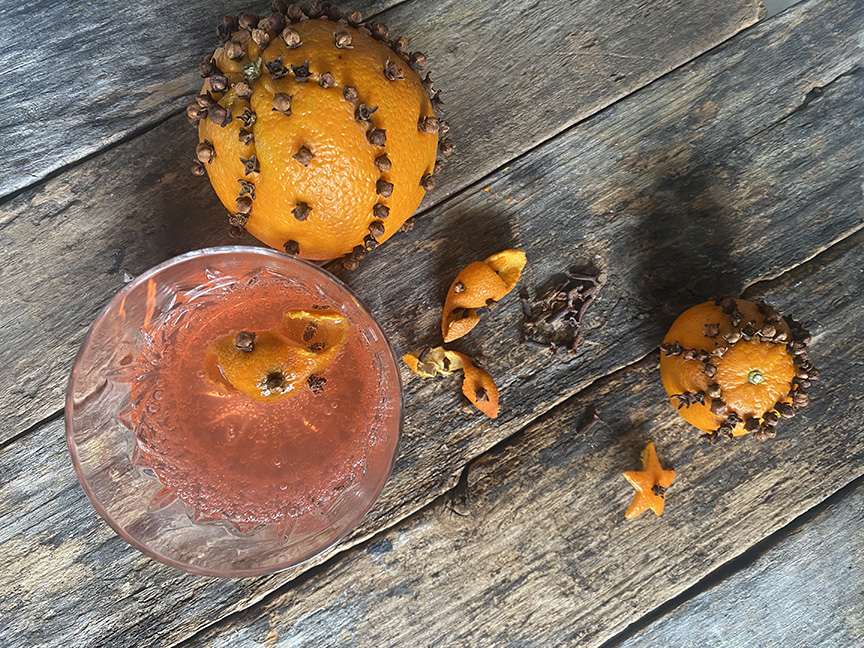
Pomander Zests for Punch
Here is another delicious use for the clove studded orange zests from above. These are amazing in an alcoholic drink or a mocktail. I like an orange seltzer these days, but I used to make a fancy cocktail with a blood orange gastrique back in the day. You can make the zests a few hours in advance and use as needed.
Ingredients:
- strips of orange zest
- whole cloves
- orange seltzer or an orange based cocktail
Method:
Poke cloves into your strip of orange zest and then twist it so it looks pretty.
Add to your drink and enjoy.
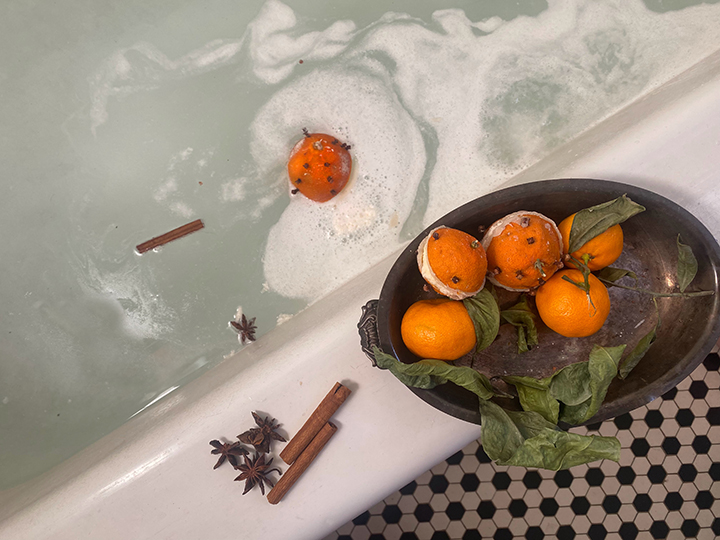
Pomander Bath Bombs
Click here for the full tutorial!
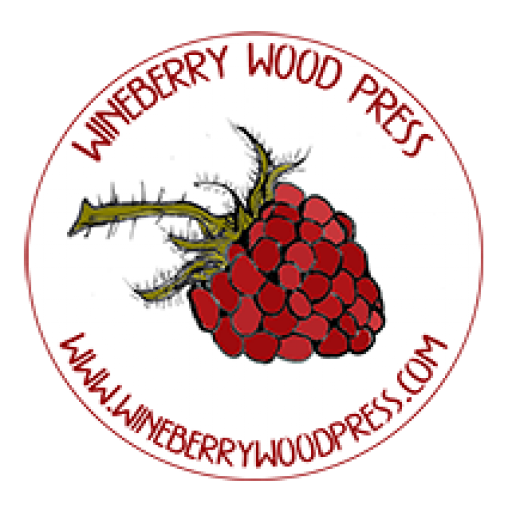
[…] Making Pomanders by Wineberry Wood Press – Oranges can seem to echo the sun. They are bright and sun coloured making them especially appropriate for the Winter Solstice. These pomanders not only look beautiful, but they smell even better. […]